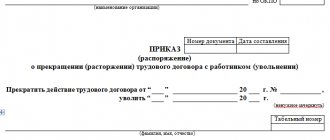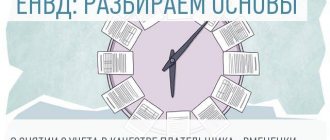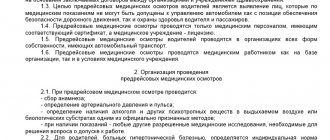How the form is structured. Key Features
Personal cards of employees are the necessary basis for creating a card index of all employees of the institution. They are stored in a file cabinet in alphabetical order. If there are many employees in an institution, then the documents can be structured by department. There are no clear legal requirements for filing a file cabinet. All that is needed is for each employee to have a personal card in the T-2 form.
Form T-2 consists of 4 pages. The information in it is divided into 11 thematic blocks. The card must be filled out by a person from the personnel service, and if this is impossible for some reason, by the head of the institution.
Form T-2 has several important features:
- Pages 1 and 2 are filled out at the time a person is hired for a position, and 3 and 4 - during the process of his work; (the images below and the sample itself are designed specifically for the document that you create when an employee joins you;
- the card is created based on a number of documents presented by the employee himself;
- for simpler and more convenient filling, the use of computer programs is allowed;
- issuance of a T-2 card by the employee himself is not allowed.
Important! Only entrepreneurs are exempt from the obligation to create personal cards. But even they often keep cards of their own accord in order to use them in management work.
General information about filling out the card
The legislation does not establish clear deadlines for creating a T-2 card. The best option is to create it at the time a person is hired for a position, but you can wait. The main thing is that the note in the work book about hiring for the position is duplicated on the card.
To successfully create a T-2 card, a number of papers are required:
- employment contract;
- an order issued by the employer;
- passport;
- work book (or other way of confirming work experience);
- certificate of pension insurance;
- diploma or other evidence of education, qualifications, special knowledge;
- for persons who may be drafted into the army - military registration documents;
- autobiography (optional - the employee can provide information orally).
Important! The specifics of the job for which a person is hired sometimes necessitates the provision of additional documents. The employer is obliged to request them so that the information on the T-2 card is complete.
To fill out section 2, which contains information about military registration, you will need the following documents:
- for people in the reserve - a temporary certificate or a full-fledged military ID;
- for people who may be drafted - confirmation that the person is subject to draft.
Valentina Mitrofanova: what happens if the employer does not keep personal cards
Building an effective HR service 2.0
19631

The latest HR course 2.0
22117
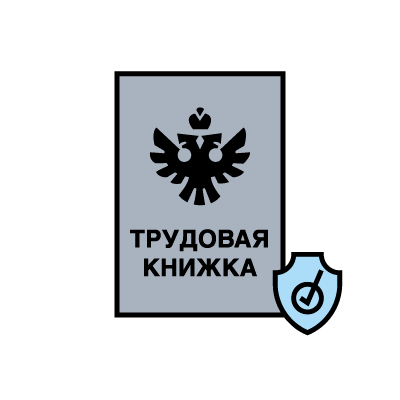
Cancellation of work books, new reporting to the Pension Fund from 2021
9852
Why do you need a personal card?
1. Storage and systematization of information. A personal card is a kind of employee dossier. In a condensed form, the card contains all the information about him: passport data, registration address, specialty, diploma number, level of foreign language proficiency, family information, etc. An employee of the HR department has the right to use a personal card in their work. For example, a personnel officer can create any benefits for an employee based on the family composition indicated on the card. An accountant can also use it - T-2 may contain information that is the basis for any additional payments. Separate records of a specialist’s qualifications can help him take a higher position or expand his functionality.
2. Document important changes. Date of entry to work, order number, transfer from one job to another, promotion, awards and incentives - all this is important information about the employee. Of course, they are accompanied by timely orders, schedules, acts and other things - however, the entire amount of knowledge about these changes is contained in the personal card - they can be seen chronologically. Storing data on a single T-2 form will help avoid misunderstandings or conflict situations. A large amount of information can be restored in case of loss. The employee signs on a personal card about all changes occurring in his career, certifying with his signature his acceptance of these changes and agreement with them.
3. Military registration. The employer is required to keep records of employees (this is specified in the Federal Law “On Military Duty and Military Service”). The accounting itself is carried out using personal cards, in which the corresponding section is filled out. Also, the employer, having filled out a personal card, must explain to employees liable for military service the procedure for fulfilling their military duty.
4. Statistics and food for thought. In general, information from T-2 can serve as a kind of database about the organization’s human resources. After analyzing this data, the enterprise administration can draw conclusions about the qualifications of its specialists, their successes and career paths, and use this knowledge for the development of the company.
What types of cards are there?
There are two official forms of cards - the usual T-2 and for a civil servant T-2GS (MS). The forms differ only in that for a civil servant, the length of service in the civil service is separately indicated, which gives the right to bonuses for length of service and to additional payments to the pension.
How to fill out the header of an employee’s personal card
The header contains OKUD and OKPO codes. In this case, OKUD is the code of the card itself, and OKPO is the code of the institution, based on statistical data. In addition, you must enter the full name of the institution (abbreviations are not allowed). After the name you need to put a comma and write the address (preferably actual, not legal). This is at your discretion; we did not indicate it in the example.

Next comes a small table, which is filled out as follows:
The date is entered in the format DD.MM.YYYY (for example, 08/01/2016). A personnel number is a serial number assigned to an employee in an institution. a TIN . A person is not required to provide it when applying for employment, so the field can be left blank. SNILS (insurance number) is required. A person must provide it in connection with Part 1 of Article 65 of the Labor Code of the Russian Federation. If this is his debut employment, then in connection with Part 4 of the same article, SNILS must be issued by the employer. “Alphabet” is a field for entering the initial letter of the employee’s last name. The nature of the work is entered based on the employer’s order. It can be permanent or temporary. Gender can be indicated by the letter M/F, or you can write the whole word.
Filling out the T-2 form by section
Section 1. General information
This section must be filled out with information from the employee's passport. Information must be entered legibly, without abbreviating anything. There are features that must be taken into account when filling out:
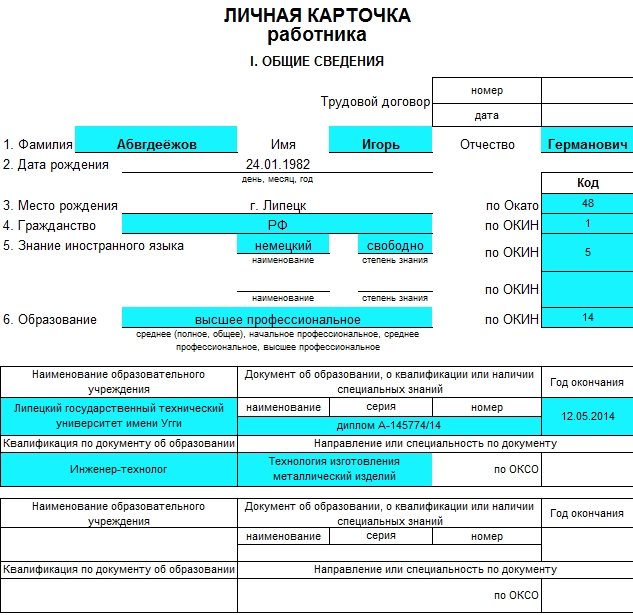
The date of birth is entered in its entirety (for example, May 23, 1982), and in the “Code” field it is duplicated in the format DD.MM.YY (05/23/82). The place of birth entry cannot be longer than 100 characters. You can use geographical abbreviations (city, region, village, etc.), but words such as village, village, kishlak, aul must be written in their entirety. If you have dual citizenship, you must indicate the name of the country of which the employee is a citizen. The name of the educational institution that the employee graduated from can be abbreviated without compromising the meaning. The length of service must be calculated on the basis of paragraph 61 of the Instructions, which was approved by Resolution No. 192p of the Pension Fund Board. The full names of family members are entered in full, without abbreviations.
If the registration and place of actual residence are identical, then the address does not need to be duplicated. The second column is simply not filled in.

The most difficult point in section 1 is encoding. Errors in them are unacceptable:
OKATO - locality code approved by Resolution No. 413 of the State Standard of the Russian Federation; OKIN – employee citizenship code (Russian Federation citizenship – 1, dual – 2, foreigner – 3, no citizenship – 4); OKSO - code of the profession or specialty acquired by the employee in the process of education; OKPDTR is another form of specialty code.
Important! The HR employee has access to all encodings. He cannot demand these codes from the person for whom the card is created.
Section 2. Information on military registration
Military records are used to complete this section. There should be no difficulties when filling out, because the requirements of the T-2 card are extremely clear. However, there are several important features:
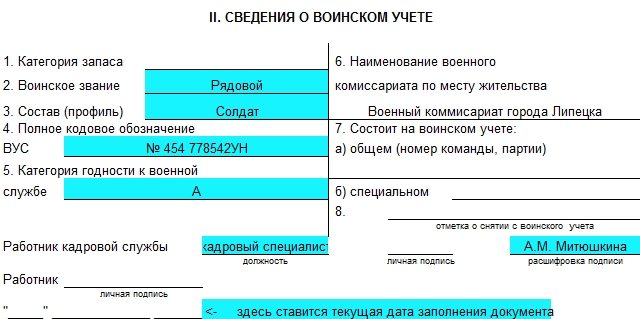
Item 1 does not need to be completed if the person applying for the job is a reserve officer. Point 3 is filled in without any abbreviations. Point 7 may change, so fill it out in pencil. Section 2 must be reviewed and signed by the HR Inspector. In addition to the signature, its transcript and the position of the inspector must be indicated. The employee must also sign this section.
Section 3. Hiring. Translations
The employee’s length of service completely depends on this section, so mistakes are unacceptable. The main document to fill out is the manager’s order. All information indicated in section 3 must be duplicated in the workbook. The employee must sign all entries in the section.
Section 4. Certification
The main point of this section is “Decision of the Commission”. This column should contain official wording, such as “suitable for the position held.” In case of discrepancy, “does not comply” is written, and if re-certification is necessary, this is indicated in the decision of the special commission.
The dates of certification and creation of the protocol are recorded in the format DD.MM.YYYY. The basis for filling out this section is the document issued to the person at the time of certification.
Sections 5-6. Training. Professional retraining
These sections are filled out according to the documents of the person applying for a job, or according to information from the personnel training department. There are no particular difficulties in filling them out. Dates must be specified in the format DD.MM.YYYY. Completing all sections is mandatory (except in cases where there is nothing to write - for example, in the absence of qualifications or retraining).
Section 7. Awards
This section includes any types of incentives that the employee received during his working life. The grounds are Article 191 of the Labor Code of the Russian Federation and local acts. In addition to notes on awards and honorary titles, they need to be listed. Abbreviations are acceptable if they do not entail a loss of meaning.
Section 8. Vacation
This section provides information about each leave received by the employee:
- regular annual leave;
- leave without pay;
- leave to care for a child.
It is necessary to indicate the type of leave, its time frame, duration and reasons for granting. If the vacation was used in parts, the working year is still calculated in full.
Important! If an employee works in an institution for a long time, then the vacation section will overflow. After this, an “Addendum to the employee’s personal card” is created. This addition should have a header similar to the header of the main document, as well as a tabular part of the missing section.
Section 9. Social benefits
This section includes all information about the benefits provided to the employee in accordance with the legislation of the Russian Federation.
Section 10. Additional information
You don't have to write anything at all in this section. The only basis for filling it out is the desire of the employer. This may contain information about the employee’s studies, attendance at certain courses, disability group, etc.
Section 11. Termination of an employment contract
The features of filling out this section are the same as those of section 3. The only difference is that the signature must be signed not only by the employee, but also by the HR inspector. The date of dismissal is the day on which the employee last actually performed his or her job.
The procedure for filling out a personal card: step by step and in detail
Document header

We enter the name of the organization and code according to OKPO - Public Classifier of Enterprises and Organizations.
Further:
- Name of the organization.
- Date of document creation.
- Employee personnel number (assigned upon hiring).
- Employee Taxpayer Identification Number.
- SNILS of the employee.
- First letter of last name.
- The nature of the work is “permanent” or “temporary”.
- Type of work - “main” or “part-time”.
- Gender - M or F.
Section I. General information
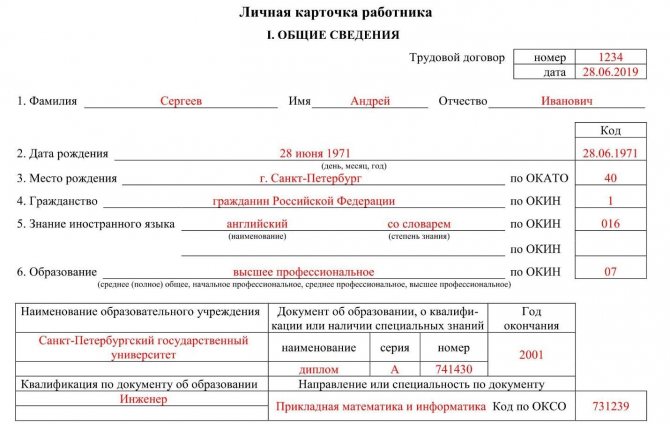
Enter:
Employment contract number.
Date of preparation.
Employee's full name.
Date of birth (month in words).
On the right in the table with the code is the same date in the format dd.mm.yyyy.
Place of birth and locality code according to OKATO. This is the All-Russian classifier of objects of administrative-territorial division.
Citizenship - and its code according to OKIN. This is the All-Russian Classifier of Population Information. For example: Citizen of Russia - code 1 Dual citizenship - code 2 Citizen of another country - code 3 Stateless person - code 4
Foreign languages and their codes according to OKIN. The degree of knowledge is indicated from three options: I read and translate with a dictionary - 1 I read and can explain myself - 2 I am fluent - 3
Education - we list all educational institutions, specialties and employee diploma numbers, with their OKSO codes. This is the All-Russian Classifier of Educational Specialties.

Profession (according to diploma) and its code according to OKPDTR. This is the All-Russian classifier of worker professions, employee positions and tariff categories.
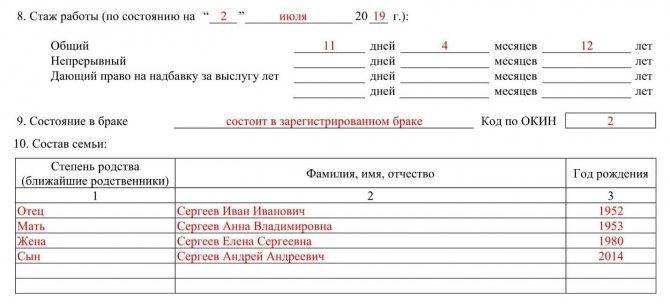
Work experience as of the time of filling out the card.
Marital status according to OKIN:
- Never been married -1.
- Married or married - 2.
- In an unregistered (civil) marriage - 3.
- Widower or widow - 4.
- Divorced - 5.
Close relatives with degree of relationship, full name and year of birth.
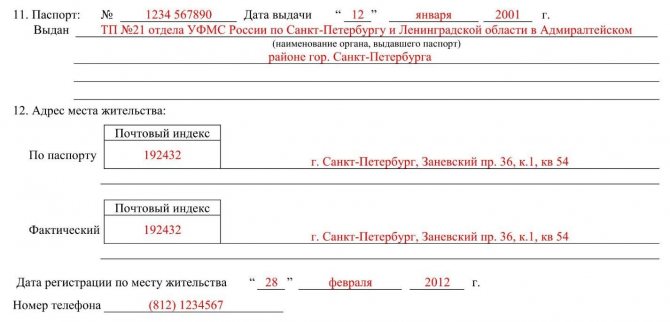
Passport details, registration, actual address and contact phone number.
Section II. Military registration
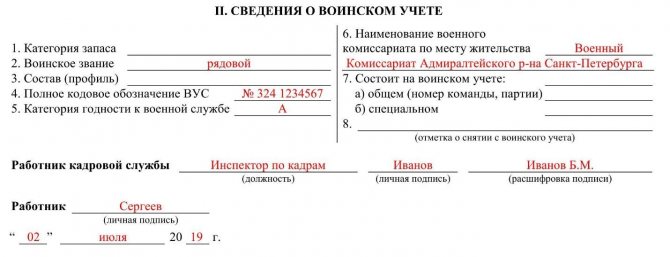
The section with military registration is filled out for all men and women liable for military service (for example, medical workers). Information is taken from a military ID or a specialist’s registration certificate.
Section III. Hiring and transfers to other jobs
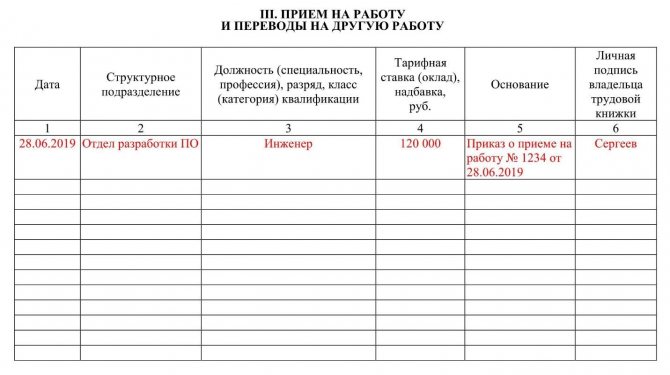
Here entries from the work book are duplicated and all changes are recorded. The employee confirms each entry with his signature.
Section IV. Certification

We indicate the procedure - when it was carried out, what the result was and the decision of the commission.
Section V. Advanced training
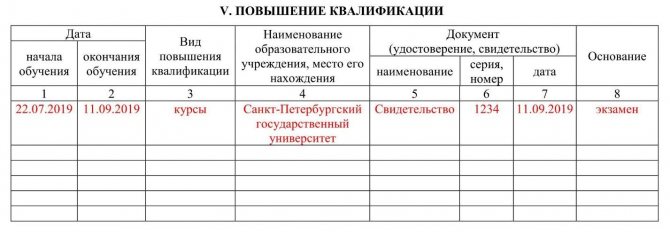
We indicate the period and type of training, the name of the educational institution, the certificate number and the basis for issue.
Section VI. Professional retraining

We write the dates of training, the specialty received, the number of the final document and the basis for it.
Section VII. Awards

We indicate all certificates or gratitude received along with their details.
Section VIII. Vacation
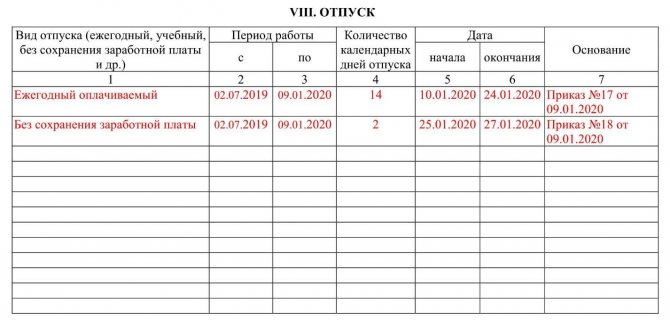
We record all the specialist’s vacations in detail and only after the fact. Leave planned for the future cannot be entered into, as it may not take place.
Section IX. Privileges

If there are grounds for benefits, then information about this must be indicated along with a link to supporting documents.
Section X. Additional Information and Dismissal
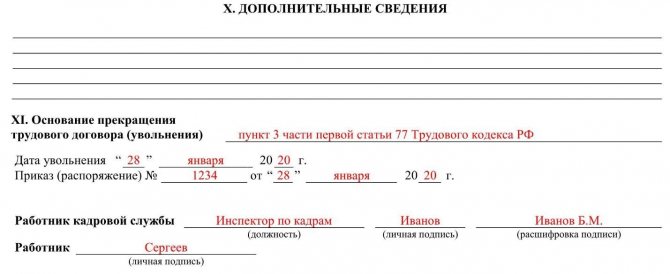
In “Additional information” you can specify data that is important for the operation of a particular enterprise. When an employee resigns, in the last section you need to enter the grounds for dismissal (with reference to the Labor Code), the date of dismissal, the date of the order and the signature of the employee and the HR specialist.
Common mistakes when filling out the T-2 form
It happens that HR employees make mistakes in an employee’s personal card. This does not have any special consequences, and it does not harm the employee himself. But if there are a lot of errors, then during an external audit the HR department may be fined for poor quality work.
The main mistakes that occur most often:
Using special characters
The slash (/) , colon (:) , equal sign (=) and other special characters cannot be used in the T-2 form. They are especially strictly prohibited in the coding zone. Inaccurate filling. Text may extend beyond the intended margins if necessary. But he should not go into the coding zone. If there is at least one letter in this zone, the card will formally be considered damaged and will need to be rewritten.
Dashes
This common mistake is because in many other documents, dashes are acceptable or even required. They should not be in the T-2 form. If there is nothing to write in the column, then it should be left completely empty.
Filling out a form on a computer
The initial filling out of T-2 (upon hiring) can be done on a computer or manually. But notes made during the employee’s work must be done strictly by hand! The employee must be familiarized with these records against receipt.
Important! A damaged card (see error 2) can only be rewritten upon initial completion. If the document was damaged during subsequent entries, it cannot be rewritten or reprinted.
We hope this material helped you obtain a personal employee card. Don't forget to save the page on social networks - it will come in handy!
What is an employee’s personal card
An employee’s personal card is a personnel document that summarizes all the information about an employee of an enterprise. Its form No. T-2 was specially developed by the Federal State Statistics Service of the Russian Federation, or Rosstat. The personal card contains the employee’s personal data and comprehensive information about his personnel movements within the enterprise: change of position, career growth, professional retraining and similar data that is directly related to the specialist’s work.
Despite the existence of a full-fledged Rosstat form of the card, since 2013 employers have been allowed to change it, delete individual blocks, add their own and, in general, develop up-to-date forms on their own.
| Valentina Mitrofanova will tell you what's new in labor legislation this week. Watch the new episode of Personnel Review. |
The legislative framework
The need for personal cards is determined by several documents:
- “On work books” , Decree of the Government of the Russian Federation dated April 16, 2003 No. 225 (as amended on March 25, 2013). Chapter II, paragraphs 12 and 13 directly state that the employer is obliged to enter information from the employee’s work book into his personal card. That is, all changes that have occurred to the employee must be recorded both in the work book and in the personal card.
- “On approval of unified forms of primary accounting documentation for recording labor and its payment” , Resolution of the State Statistics Committee of the Russian Federation dated 01/05/2004. The contents of the personal card are described here and individual recommendations for filling out are given.
- “On approval of the Regulations on military registration” , Decree of the Government of the Russian Federation of November 27, 2006 N 719 (as amended on March 16, 2019). Here we examine in detail the second section of the card, dedicated to the registration of citizens liable for military service. Carrying out such accounting is also the responsibility of the employer.
